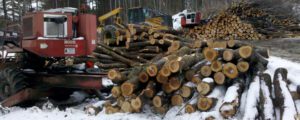 In August, VCRD was honored to serve as a partner with the Windham Foundation to facilitate their thirty-fifth Grafton Conference. On the 50th year anniversary of the foundation, they wisely chose to bring together key industry and policy leaders to address the topic: “Vermont’s Forest Economy: Advancing Creativity and Entrepreneurship in Value-Added Forest Products.”
In August, VCRD was honored to serve as a partner with the Windham Foundation to facilitate their thirty-fifth Grafton Conference. On the 50th year anniversary of the foundation, they wisely chose to bring together key industry and policy leaders to address the topic: “Vermont’s Forest Economy: Advancing Creativity and Entrepreneurship in Value-Added Forest Products.”
The working forest in VT is no accident; it is the result of innumerable economic decisions made by generations of rural families as they make a living from the land. Their stewardship contributes so much to us all through recreation, beauty, natural habitats, clean air and water, and a creative variety of wood products, but their role as stewards, and their importance in providing an economic foundation to our working landscape, has been underappreciated.
One of the gravest dangers confronting the future of Vermont’s working landscape is the threat to the economic vitality of the forest products industry. In recent decades we’ve seen mill closings and a loss of capacity throughout the industry. This is accompanied, unfortunately, by the breakup of forested tracks for other development: often sprawling housing units that take land permanently out of production.
It’s wonderful to see the forest products economy celebrated by the Windham Foundation, and to see forward thinking about how it is innovating to support the ecology and prosperity of Vermont into the future.
It is encouraging to see an emerging recognition and respect for the hardworking Vermonters, who work in our forests and build their livelihood from them. In our global economy, managing our forests will mean conservation in action. Vermonters told VCRD through the Council on the Future of Vermont that they did not want the state to become a “parkland for the well-to-do” or an inauthentic rural Disneyland. I believe that Vermonters are committed to a strong and ecological economy that sustains our farms and our forests in active use as their best use, and so keeps the strong working landscape vital — for all it does for us as individuals and as our brand signature to attract tourism, other businesses, and residents. We all choose to live here for a reason, and the forested backdrop to our lives is part of it.
But to keep forests as forests, we will need to define and advance opportunities for businesses to build profit margins at each component part of the industry, including landowners, loggers, trucking, milling, and the rich diversity of value-added products, from furniture and buildings to bowls, toys, and works of art. The industry and the public will need to work in greater unity: building bridges between the components of the industry, supporting profitability through the chain of production, and ensuring financial viability of good land use practices.
The partnership needs to be deeper than just the businesses in this industry. We ought to buy local (“Local Wood, Local Good”) but also to support the opportunities of entrepreneurs to seize global opportunities. We need to work as a team to strengthen the Vermont brand for mutual benefit. We should work as environmentalists to recognize and respect entrepreneurs and innovators who advance this economy, thereby advancing all that it contributes to all of us.
Not to be maudlin, but remember the old line, “Have you thanked your farmer today?” Maybe we should thank the landowner who gives us free run of his woods, the logger whose hard labor brings out the wood, the mill owner whose business is a local economic anchor, and the value added artisan who constructs beautiful Vermont products that, just like local foods, let us connect back to the land.
